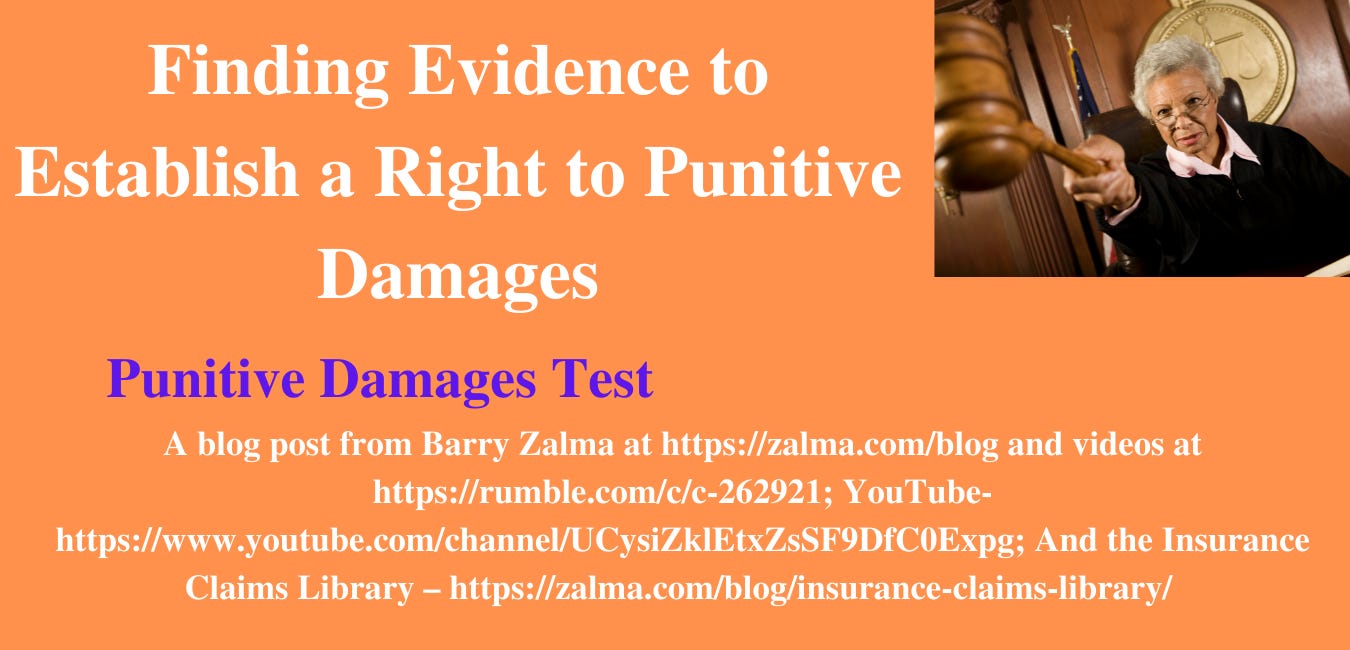Finding Evidence to Establish a Right to Punitive Damages
Punitive Damages Test
Read the full article at https://www.linkedin.com/pulse/finding-evidence-establish-right-punitive-damages-zalma-esq-cfe and at https://zalma.com/blog plus more than 3950 posts.
Posted on October 18, 2021 by Barry Zalma
In 1989, Exxon’s supertanker grounded on a reef off Alaska spilling millions of gallons of crude oil. The accident occurred after the tanker’s captain—who had a history of alcohol abuse and whose blood still had a high alcohol level 11 hours after the spill—inexplicably exited the bridge, leaving a tricky course correction to unlicensed subordinates.
Exxon spent some $2.1 billion in cleanup efforts, pleaded guilty to criminal violations occasioning fines, settled a civil action by the US and Alaska for at least $900 million, and paid another $303 million in voluntary payments to private parties. Other civil cases were consolidated against Exxon, the captain, and others to recover economic losses suffered by those suing Exxon. The trial jury awarded $287 million in compensatory damages to some of the plaintiffs; others had settled their compensatory claims for $22.6 million; awarded $5,000 in punitive damages against the captain and $5 billion against Exxon. The Ninth Circuit ultimately remitted the punitive damages award against Exxon to $2.5 billion.
In Exxon Shipping Co. v. Baker, 128 S.Ct. 2605, 171 L.Ed.2d 570 (U.S. 06/25/2008), the US Supreme Court concluded that the punitive damages award against Exxon was excessive as a matter of maritime common law and the award should be limited to an amount equal to compensatory damages. Applying this standard to the Exxon case, the Supreme Court took for granted the District Court’s calculation of the total relevant compensatory damages at $507.5 million. A punitive-to-compensatory ratio of 1:1 thus yielded maximum punitive damages in that amount.
The test to determine if punitive damages are proper requires the court to consider the degree of the reprehensibility of the defendant’s conduct, the disparity between the actual or potential harm suffered by the plaintiff and the punitive damages award; and the difference between the punitive damages awarded by the jury and the civil penalties authorized or imposed in comparable cases.
The United States Supreme Court has instructed courts that to arrive at a conclusion about whether a punitive damages award is “grossly excessive,” they are to consider three “guideposts.”
The degree to which defendant’s conduct is reprehensible.
The disparity between the punitive and compensatory damages awards, usually in the form of a ratio.
Compare the punitive damages award to legislatively prescribed civil and criminal penalties for comparable misconduct.
The Supreme Court suggested that reviewing courts may consider not only the compensatory damages awarded by the jury, but also the potential harm that could have resulted from the defendant’s acts.
The Oregon Supreme Court in Hamlin found that although compensatory damages were small and the ratio between the punitive and compensatory damages — 22:1 — was in the low double digits the punitive damages should remain. Although it found that the ratio was higher than would be constitutionally permissible if the compensatory damages were more substantial, the punitive damages awarded by the jury were not so high that it made the award “grossly excessive.” The amount of the punitive damages award — $175,000 —also was not so high that it exceeded, rather than served, the state’s interests in deterring and punishing the violation of state criminal statutes.
Every lawyer who represents a plaintiff suing an insurance company for the tort of bad faith or the lawyer defending an insurer against claims that it committed the tort of bad faith, must understand, why punitive damages can be awarded to punish an insurer. Through an analysis of punitive damages as applied in the United States to insurance bad faith suits, this book will analyze why the various states allow judges and juries to award punitive damages against insurers in civil litigation.
In Mississippi, punitive damages are controlled by statute, Miss. Code Ann. § 11-1-65(1)(a) that instructs:
In all cases involving an award of punitive damages, the fact finder, in determining the amount of punitive damages, shall consider, to the extent relevant, the following: the defendant’s financial condition and net worth; the nature and reprehensibility of the defendant’s wrongdoing, for example, the impact of the defendant’s conduct on the plaintiff, or the relationship of the defendant to the plaintiff; the defendant’s awareness of the amount of harm being caused and the defendant’s motivation in causing such harm; the duration of the defendant’s misconduct and whether the defendant attempted to conceal such misconduct; and any other circumstances shown by the evidence that bear on determining a proper amount of punitive damages.
If neither party presented evidence of a defendant’s net worth at trial, neither party may challenge on appeal either the inadequacy or the excessiveness of a punitive damages award. [Woodkrest Custom Homes Inc. v. Cooper, 108 So.3d 460, 470 (Miss. Ct. App. 2013) (quoting C & C Trucking Co. v. Smith, 612 So.2d 1092, 1102 (Miss. 1992)); accord Moore v. McDonald, 210 So.3d 563, 568 (¶15) (Miss. Ct. App. 2017)
First and foremost, lawyers and litigants must understand that unlike contract or tort damages punitive damages are awarded to punish the tortfeasor sufficiently to act as a deterrent to others who may be considering to act similarly. Until the 1950’s a person suing an insurance company could only recover contract damages. The most the insured could recover, if an insurer breached the contract of insurance, is the benefits promised by the policy. When the courts created the tort of bad faith they changed contract law enormously by allowing unhappy insureds to sue insurers for both contract and tort damages, including punitive damages.
Basic tort damages are designed and expected to provide indemnity to the plaintiff. Tort damages attempt to use money to place the plaintiff in same situation he or she was in before injured by a tortfeasor.
The award of punitive damages provides the plaintiff with sums greater than the damages actually incurred as a result of the tort in a sum sufficient to punish the defendant and deter the defendant – and others – from repeating the wrongful conduct. Punitive damages do not help the insured return to the situation he or she was in before the insurance contract was breached. If they collect the punitive damages the insured is placed in a better position than he or she was in before the breach of the contract. In addition, since punitive damages are not compensatory, the plaintiff will find that the government will require the plaintiff to pay income taxes on the awarded punitive damages. [Commissioner of Int. Rev. v. Obear-Nester Glass Co., 217 F.2d 56 (7th Cir., 1954)]
To obtain a judgment awarding punitive damages, the plaintiff must establish that:
The insurer lacked an arguable or legitimate basis for denying the claim, and
The insurer committed a wilful or malicious wrong, or acted with gross and reckless disregard for the insured’s rights. [State Farm Mut. Auto. Ins. Co. v. Grimes, 722 So. 2d 637, 641 (Miss. 1998)
Punitive damages may not be awarded unless both of these prongs are satisfied. [Mitchell v. State Farm Fire & Cas. Co., 954 F.3d 700 (5th Cir. 2020)] There is no bright-line test, but consistent with due process, punitive damages must be both reasonable and proportionate to the amount of harm to the plaintiff and to the general damages recovered.
Adapted from the book: Zalma on Insurance Claims Part 106 Third Edition available at Amazon.com
© 2021 – Barry Zalma
Barry Zalma, Esq., CFE, now limits his practice to service as an insurance consultant specializing in insurance coverage, insurance claims handling, insurance bad faith and insurance fraud almost equally for insurers and policyholders.
He also serves as an arbitrator or mediator for insurance related disputes. He practiced law in California for more than 44 years as an insurance coverage and claims handling lawyer and more than 54 years in the insurance business.
Subscribe to Excellence in Claims Handling at https://barryzalma.substack.com/welcome.
He is available at http://www.zalma.com and zalma@zalma.com. Mr. Zalma is the first recipient of the first annual Claims Magazine/ACE Legend Award. Over the last 53 years Barry Zalma has dedicated his life to insurance, insurance claims and the need to defeat insurance fraud. He has created the following library of books and other materials to make it possible for insurers and their claims staff to become insurance claims professionals.
Go to training available at https://claimschool.com ; articles at https://zalma.substack.com, the podcast Zalma On Insurance at https://anchor.fm/barry-zalma; Follow Mr. Zalma on Twitter at https://twitter.com/bzalma; Go to Barry Zalma videos at https://www.rumble.com/zalma ; Go to Barry Zalma on YouTube- https://www.youtube.com/channel/UCysiZklEtxZsSF9DfC0Expg; Go to the Insurance Claims Library – https://zalma.com/blog/insurance-claims-library/ The last two issues of ZIFL are available at https://zalma.com/zalmas-insurance-fraud-letter-2/ podcast now available at https://podcasts.apple.com/us/podcast/zalma-on-insurance/id1509583809?uo=4






